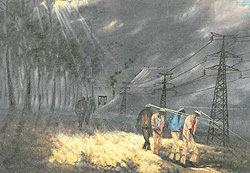John Koenakeefe Mohl was born on 29 September 1903 in Dinokana, Zeerust in the North-West Province. Mohl's father was a carpenter who sculpted objects such as chairs and mealie stampers. During his youth, Mohl drew with 'pepa' on rocks and made clay objects. He attended primary school in Dinokana where his teachers reprimanded him for constantly drawing in class. Mohl's father eventually withdrew him from school to tend to the goats. Nevertheless, Reverend Hale soon recognised Mohl’s talent and convinced his father to allow him to draw.
 Only patch of sunshine 1968. Source: artnet.com
Only patch of sunshine 1968. Source: artnet.com
Mohl attended the Moeding Training Institute (later known as Tigerkloof Training School) where he attained a teacher’s diploma. He subsequently accompanied a German artist to South West Africa (now Namibia) where he studied painting at the Windhoek School of Art. The Missionary Society and the Lutheran Church then sent him to DÁ¼sseldorf, West Germany where he studied art at the Kunst-Akademie during the following five years.
The artist later returned to South Africa and settled in Sophiatown, where he started running art classes from his home. His art school was known to his peers as the ‘White Studio’. He was one of the first Black artists to be involved in art education and training. In the late 1950s, he was prevented from operating a business; therefore he established the Apollo Art gallery under the name of a Belgian, Frank van Melten (documented as van Walter and van Malter).
When Sophiatown was demolished, Mohl moved to Dube, in Soweto, where he taught at Madiban High School and at Orlando High School. He and his family later moved to other areas in Soweto, first Rockville and then Moroka. It was in the latter where, beginning in the mid 1970s, Mohl began to exhibit his paintings in his garden and sell them to Soweto residents, as well as to tourists. He steered away from Commercial Galleries and publicity but exhibited in conjunction with other artists in local expositions. He was a founding member of the, 'Artists under the sun exhibitions' in Joubert Park, Johannesburg, where he held regular displays.
His desire was to paint what was known to him, therefore township scenes were often the theme of his works. His preferred medium was oil paint and his paintings often depicted panoramic vistas with atmospheric qualities. Mohl sometimes worked in an impressionistic style, capturing the various moods of township landscape; early morning, rainy scenes and shadows of approaching night and early dusk were his favourite scenes.
To enhance the mood of the work he often worked in monochromatic hues. His fine, gentle and sensitive brushwork can be traced back to his extensive art training both locally and abroad. He was a fine colourist with a mature style that stood out amongst his peers (see figures one and two).
A famous anecdote, representative of Mohl’s character was when he was once approached by a white admirer. He advised Mohl not to concentrate on landscape oil paintings, but to paint figures of his people in poverty and misery. Landscape, he was told, had become the field where Europeans had advanced far in perfecting its painting. In response Mohl challenged this rhetoric and said: “But I am African, and when God made Africa, he also created beautiful landscapes for Africans to admire and paint.”
Mohl died in 1985 in Johannesburg. His paintings are part of a number of collections both local and international. Amongst these are the Doreen Khama Collection, the Johannesburg Art Gallery, the Pretoria Art Gallery, and private collections in Germany.
Loots, A. (2001) “The Early Pioneer Artists of South Africa - John Koenakeefe Mohl” [online] Available at: vgallery.co.za [Accessed 24 April 2009]|Jenkins, D. (unknown) “African Oil Paintings ”“ The Majesty of Light and Colour” [online] Available at: southafricanartists.com [Accessed 24 April 2009] |Sack, S. (1988). The Neglected Tradition, Johannesburg: Johannesburg Art Gallery.

